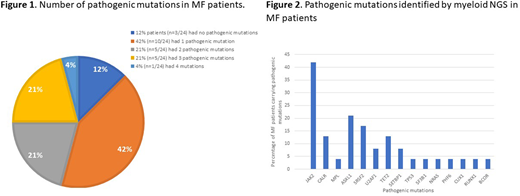Background: Myelofibrosis (MF) is typically characterized by one of three classic driver mutations identified in the JAK2, CALR, and MPL genes. However, a small proportion of MF patients are triple negative and do not carry any of these driver mutations. In the latest WHO 2016 classification of myeloid neoplasms, the authors recommended further genetic testing in this subset of patients to confirm clonality 1.
In MF, mutations in ASXL1, EZH2, IDH1, IDH2, SRSF2, U2AF predicted shorter survival and increased risk of leukemic transformation 2,3,4. The presence of one or more of these mutations defined a higher risk category termed high molecular risk (HMR) 4. In transplant eligible patients with HMR, early transplantation should be considered.
The hematological malignancy diagnostic service (HMDS) at University College London Hospital (UCLH) serves 8 secondary or tertiary hospitals in North London. At our HMDS, transplant eligible patients with suspected MF are offered the TruSight Myeloid NGS (Illumina) with a panel of 54 genes. The panel is run on the MiSeq Illumina platform. All results are integrated by the oncogenomics multidisciplinary team (MDT).
Aim: We evaluated the diagnostic, prognostic, and therapeutic utilization of 54 gene panel myeloid NGS in management of MF patients.
Method: Eligible patients were those: (1) Aged >18 years at diagnosis of MF, with a diagnostic date between 1/1/2017 and 12/31/2019. (2) Availability of diagnostic bone marrow samples at HMDS at UCLH. Data was retrospectively collected from patients' medical records. Gene variance screening was performed as described before 5.
Results: 67 patients were referred to HMDS at UCLH with suspected myelofibrosis between 1/1/2017 and 12/31/2019. 36 patients were included in this retrospective audit (94% [n= 34/36] with primary MF (PMF) and 6% [n=2/36] with secondary MF). The median age at MF diagnosis was 69 years (range 48-90 years). 55.5% patients (n=20/36) had JAK2 mutation, 13.8% (n=5/36) had CALR mutation, 5.5% (n=2/36) had MPL mutation, 27.3% (n=9/36) were negative for JAK2, CALR and MPL mutation (triple negative) by polymerase chain reaction (PCR).
24/36 patients had myeloid NGS. This includes 15/17 (88%) transplant eligible patients and 9/19 (47%) transplant ineligible patients. 12% patients (n=3/24) had no pathogenic mutations, 42% (n=10/24) had 1 pathogenic mutation, 21% (n=5/24) had 2 pathogenic mutations, 21% (n=5/24) had 3 pathogenic mutations, and 4% (n=1/24) had 4 mutations (Figure 1). The most commonly identified pathogenic mutation by NGS was JAK2 (42%), followed by ASXL1 (21%), SRSF2 (17%), TET2 (13%), CALR (13%). Other less frequent mutations were identified in U2AF1 (8%), SETBP1 (8%), MPL (4%), TP53 (4%), SF3B1 (4%), NRAS (4%), PHF6(4%), CUX1(4%), RUNX1 (4%), BCOR (4%) (Figure 2). 57% (n=4/7) triple negative patients showed evidence of clonal hematopoiesis by NGS.
Compared with our standard PCR, NGS showed 88% concordance in identifying JAK2, MPL and CALR mutations. 12% mutations identified by PCR were not identified by NGS. No cryptic mutations were identified.
29% patients (n=7/24) had high molecular risk, of whom 4 were transplant eligible with a DIPSS-plus score of intermediate-2 or above. All of the 4 patients were referred for early Hematopoietic Stem Cell Transplant (HSCT). Despite early HSCT, 2 patients showed early relapse and disease progression of MF.
Conclusion: Myeloid NGS showed clinical utility in diagnosis of MF through verifying clonal hematopoiesis in triple negative patients and refining clinical decisions relating to HSCT.
References:
1.Arber DA, et al. The 2016 revision to the World Health Organization classification of myeloid neoplasms and acute leukemia. Blood 2016; 127:2391-2405
2.Vannucchi AM, et al. Mutations and prognosis in primary myelofibrosis. Leukemia 2013; 27:1861-1869
3.Guglielmelli P, et al. The number of prognostically detrimental mutations and prognosis in primary myelofibrosis: an international study of 797 patients. Leukemia 2014; 28:1804-1810
4.Tefferi A, et al: MIPSS70+ Version 2.0: Mutation and Karyotype-Enhanced International Prognostic Scoring System for Primary Myelofibrosis. JCO 2018; 36 :1769-1770
5.Nacheva E, et al. Absence of damaging effects of stem cell donation in unrelated donors assessed by FISH and gene variance screening. Bone Marrow Transplantation 2020; 55:1290-1296
No relevant conflicts of interest to declare.
Author notes
Asterisk with author names denotes non-ASH members.


This feature is available to Subscribers Only
Sign In or Create an Account Close Modal